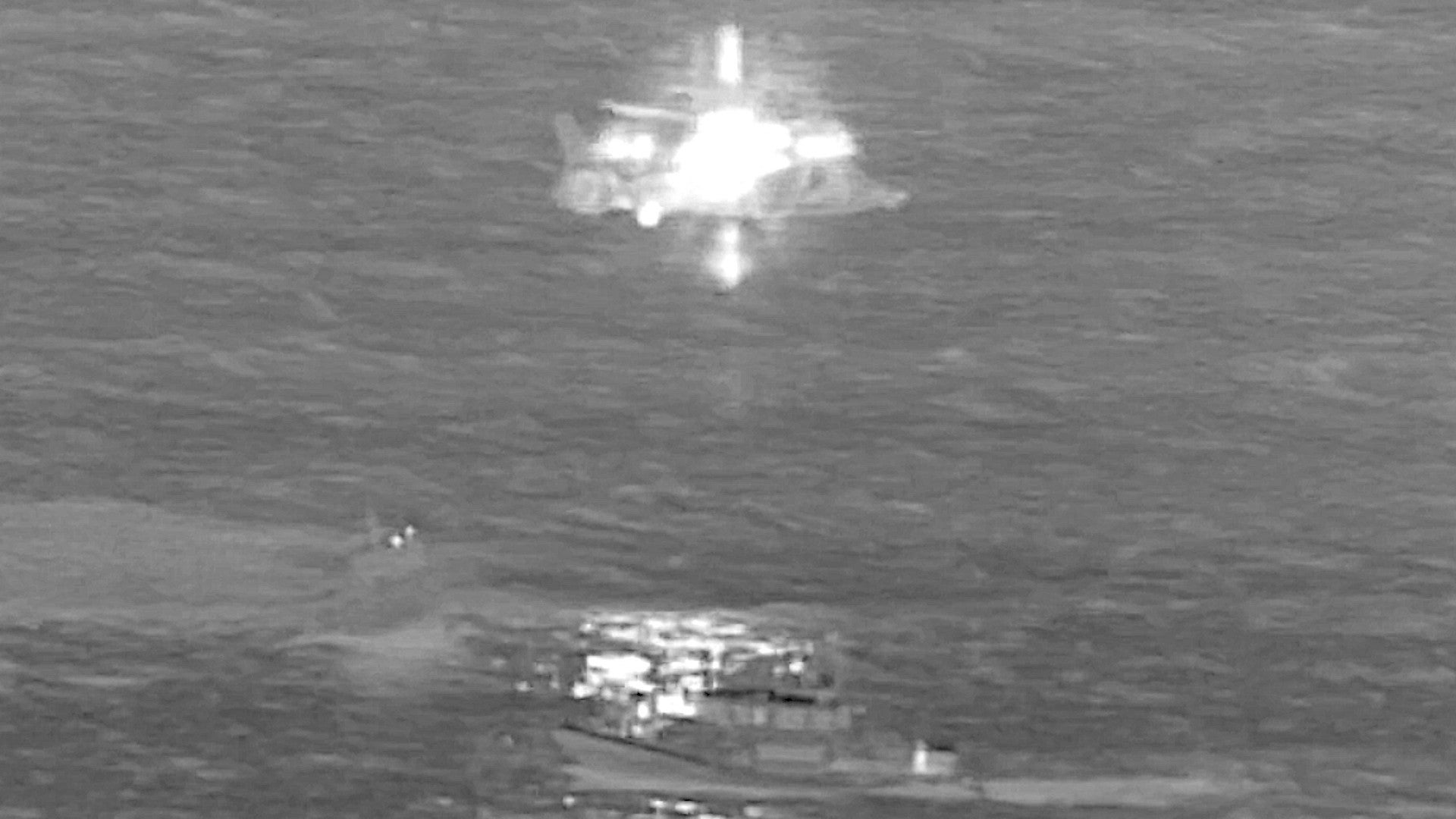Details are still emerging about the dramatic rescue of the pilot and co-pilot of a Boeing 737 freighter belonging to Transair Cargo after they to ditched their plane off the coast of Hawaii early this morning. The U.S. Coast Guard says that personnel onboard one of its MH-65 Dolphin helicopters had to hoist one of the individuals out of the water after the plane sunk in waters 150 feet deep. They offered to do the same for the other Transair crew member, who had scrambled on top of cargo that the plane had been carrying that was floating nearby, but they declined and were subsequently picked up by a boat from the Honolulu Fire Department.

Transair Flight T4810, a Boeing 737-275C that carries the U.S. civil registration code N810TA, came down off Hawaii at around 1:40 AM this morning, local time. The crew had reported an unspecified engine malfunction shortly after taking off from Daniel K. Inouye International Airport in Honolulu on the Hawaiian island of Oahu. They attempted to return to the airport before being forced to ditch, according to a statement the Federal Aviation Administration (FAA) provided to CNN. FAA, as well as the National Transportation Safety Board (NTSB), will investigate the mishap.
“Around 1:40 AM local time the USCG Joint Rescue Coordination Center [JRCC] Honolulu received a report of a downed Boeing 737 inter-island transport plane with 02 POB [personnel on board] approximately 02 NM [nautical miles] south of Kalaeloa, Oahu,” the public affairs office for the 14th Coast Guard District, which is headquartered in Honolulu, told The War Zone. The JRCC immediately directed the launch of the MH-65, as well as an HC-130 Hercules fixed-wing search-and-rescue aircraft, from nearby Air Station Barbers Point.


The Sentinel class cutter USCGC Joseph Gerczak was conducting routine operations in the area and was also redirected to the area and another small boat was deployed from Honolulu to where the plane had ditched. “Sector Honolulu requested assistance through local first responders,” the 14th Coast Guard District.

The Coast Guard has offered details about what sounds like a dramatic rescue of the Transair crew. “Around 2:30 AM the MH-65 located the white/orange Boeing 737 TransAir cargo plane in a debris field and observed the two persons,” the 14th Coast Guard District explained to The War Zone. “The MH-65 made visual contact with the two persons.”
The video below shows a Transair Cargo 737 landing at Kahului Airport in Hawaii last year.

“One survivor was located on the tail of the aircraft, went into the water as the plane sunk, and was hoisted by the MH-65 and transported to Queen’s Medical Center for evaluation; the other survivor was located on top of some floating packages, declined a hoist, and was picked up by a Honolulu Fire Department (HFD) rescue boat for transport to shore,” the statement continued. “The aircraft apparently sunk approximately 1.5NM south of [sic] Ewa Beach, in approximately 150 FT [feet] of water.”
“Our crews often train closely with our counterparts in the Honolulu Fire Department for situations just like this one,” Coast Guard Petty Officer 2nd Class Masato Nakajima, a Sector Honolulu watchstander, said in a separate statement. “That training paid off and we were able to quickly deploy response assets to the scene and recover the two people aboard the aircraft.”
Hawaii News Now
subsequently reported that the crew member that the Coast Guard pulled from the water is presently in critical condition, while the individual that the Honolulu Fire Department Boat rescued is in serious condition “with a head injury and multiple lacerations.
The Coast Guard said that it planned to evaluate the extent of any possible pollution resulting from the mishap when the sun came up.
Exactly what happened remains unclear, publicly available air traffic control recordings indicate that the engine issue developed quickly and was very serious. “We’ve lost number one engine and we’re coming straight to the airport,” one crew member can be heard saying at one point in the audio, which you can listen to in full below. “We’re going to lose the other engine, too. It’s running very hot.”

Transair Cargo, which started operations in 1982, regularly flies cargo between Hawaii’s individual islands on its fleet of Boeing 737 and Shorts SD3-60-300 cargo planes. The company’s 737’s are definitely aging, with the one that went down today having rolled off the assembly line in 1975. The War Zone has reached out to the company for comment about the incident.
In the meantime we can only hope that the two Transair crew members will now fully recover from their ordeal and that the crash will not have any lasting environmental impact.
We will continue to update this story as more information becomes available.
UPDATE: 3:30 PM EST —
Transair Cargo has provided the following statement from CEO Teimour Riahi:
Early this morning one of our cargo aircraft made an emergency water landing offshore of Oahu after reporting engine trouble.
Two employed flight crew were aboard. Both were rescued by first responders and are receiving medical care.
We are working with the Coast Guard, the FAA and NTSB to secure the scene and investigate the cause.
Our most immediate concern is the care and recovery of our colleagues. We will provide additional information as soon as it becomes available.
UPDATE: 5:45 PM EST —
Twitter user @JCTorrisi has alerted us to interviews that KHON2 News, a local Fox/CW affiliate in Hawaii, did with Coast Guard MH-65 pilots and rescue swimmers that were involved in the response to this mishap. You can watch those interviews in full, which provide interesting additional perspectives, below.


Contact the author: joe@thedrive.com
